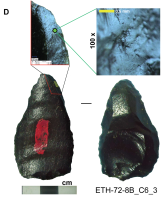About a week ago at his blog Naturalis Historia Joel Duff discussed the recent discovery in Argentina of the 240 million year old fossilised remains of a communal dinosaur latrine [EDIT: silly me, they’re not dinosaurs but Dinodontosaurs]. I suggest you go there for the details, but the most important point is that we have a number of sites of ~900 square metres in area and containining tens of thousands of individual coprolites (fossil poop). When originally reading his post I thought to myself that if I ended up writing my own piece on the subject it would be called “giant steaming piles of dinosaur shit” – while I have clearly changed my mind since this will still do for a subtitle, for reasons that will become clear.
Duff asked: “how [do] young earth creationists (YECs) interpret this fossil find?” Timothy L. Clarey, in Digging Into a Fossil Outhouse, provides an answer. He opens his article:
A group of paleontologists reported the discovery of concentrated fields of fossilized dung, called coprolite, in northwest Argentina. The closely-spaced dung piles are seen as evidence of gregarious behavior from large herbivores. However, does the great Flood provide a better explanation? Continue reading →
 (You may want to make that a little bigger.)
(You may want to make that a little bigger.)




